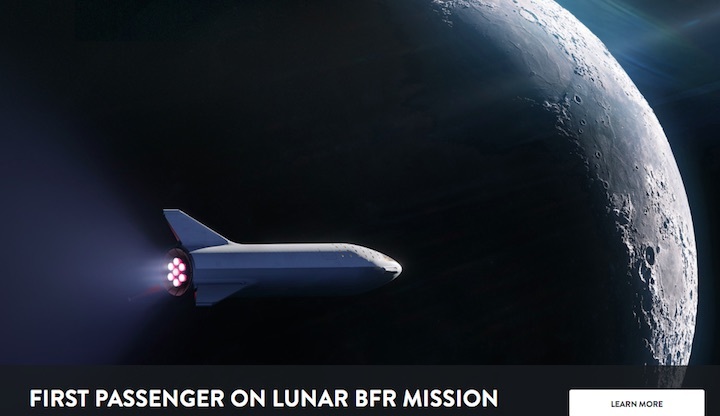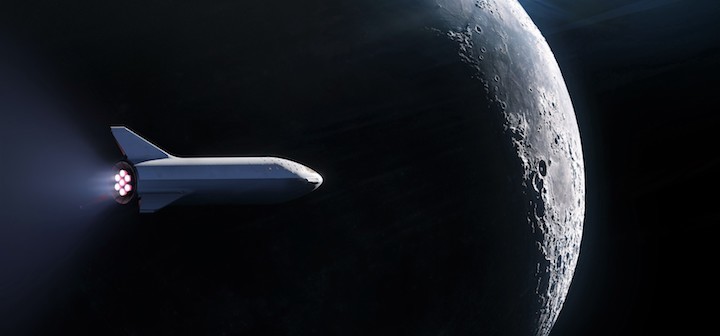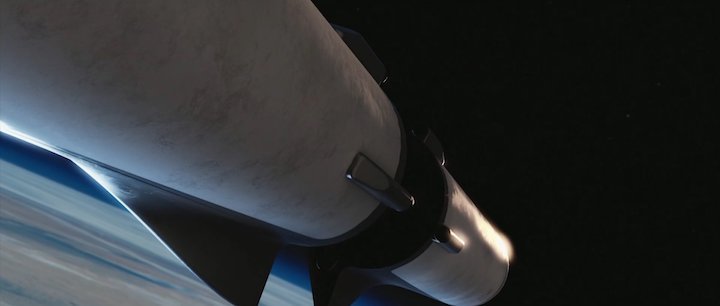14.09.2018

SpaceX has signed the world’s first private passenger to fly around the Moon aboard our BFR launch vehicle - an important step toward enabling access for everyday people who dream of traveling to space.
Only 24 humans have been to the Moon in history. No one has visited since the last Apollo mission in 1972. Find out who’s flying and why on Monday, September 17 at 6pm PT.
Quelle: SpaceX
+++
SpaceX says it will send someone around the Moon on its future monster rocket
SpaceX has signed its first customer to fly on the company’s huge new rocket, the BFR, the company says. The passenger will fly on the monster ship around the Moon, though there are no details yet regarding when the trip will happen. SpaceX says it will announce who is flying — and why — on Monday, September 17th.
The BFR, or the Big Falcon Rocket, is the giant rocket that SpaceX is currently developing to send humans to the Moon and Mars. The BFR design, presented by CEO Elon Musk last year, consists of a combined rocket and spaceship, called the BFS for Big Falcon Spaceship. The main rocket will have 31 main Raptor engines and be capable of sending up 150 tons to low Earth orbit, according to that presentation.
In February 2017, SpaceX announced plans to send two passengers around the Moon on the company’s Falcon Heavy rocket, claiming that the flight would happen at the end of 2018. SpaceX never named the passengers, and, ultimately, Musk admitted during the inaugural flight of the Falcon Heavy that the trip probably wasn’t going to happen. “We’re sort of debating whether to do that on Falcon Heavy or BFR,” Musk told The Verge before the launch in February of this year. “It will sort of depend on how well BFR development is going as to whether we focus on BFR for deep-space human flight or whether we do that on Falcon Heavy.”
t’s unclear if this new passenger being announced is one of the two original passengers from the Falcon Heavy flight or a new customer altogether. Musk hinted on Twitter that the customer might be from Japan. SpaceX says it will give more details on Monday, and the company has set up a live stream for the announcement.
Musk gave a detailed presentation about the design for the BFR last September during the annual International Astronautical Congress. The presentation called for a slimmed-down version of the vehicle, using 31 main engines, compared to the version Musk had pitched the year before, which would have had 42. However, Musk confirmed on Twitter that the rendering of the BFR posted by SpaceX for the announcement was a new version of the vehicle.
Both the BFR and BFS are reusable and designed to use their engines to lower themselves to the ground, much like how the Falcon 9s land. Musk envisions using the BFR for setting up a Moon base on the lunar surface, as well as starting a human settlement on the surface of Mars. However, Musk also noted that the BFR could be used to launch satellites, and he even proposed the idea of using the vehicle to do point-to-point travel. Conceivably, passengers on Earth could ride the rocket to distant cities, with travel times lasting just 30 minutes for destinations on the other side of the planet.
Musk noted last year that his ultimate goal is to transition SpaceX’s focus from the company’s current line of vehicles — the Falcon 9, the Falcon Heavy, and the Dragon spacecraft — to the BFR. “All our resources will turn toward building BFR,” Musk said last year. “And we believe we can do this with the revenue we receive from launching satellites and servicing the space station.”
It’s still uncertain when the BFR will be complete, though. The company has already started working on the rocket near SpaceX’s headquarters in Hawthorne, California, and it also received approval to develop the vehicle at a new facility in the Port of Los Angeles. Additionally, SpaceX has started doing tests on subscale versions of the Raptor engine that will power the BFR. SpaceX president Gwynne Shotwell recently said she believes that the BFS will do short hop tests sometime by the end of 2019. These tests will be similar to SpaceX’s initial Grasshopper tests of the Falcon 9, where the rocket climbs to a certain height above Earth and then attempts to land gently back on the ground.
Musk has predicted that the BFR’s first trip to Mars could happen in 2022, which has been considered to be an extremely optimistic goal. The development cost of the BFR is expected to be around $10 billion, and it’s still unclear if SpaceX’s profits will be enough to cover that. Plus, Musk is known for setting unrealistic timelines. The Falcon Heavy was supposed to launch as early as 2013 or 2014, but it didn’t get off the ground until this year. Seeing as how the BFR is a much bigger and more complex vehicle, it seems reasonable that its development will take longer than expected, too.
Quelle: THE VERGE
---
Update: 15.09.2018
.
SpaceX has signed a private passenger for the first BFR launch around the Moon

SpaceX has officially announced that it has signed a private customer for what may be the first BFR launch to the Moon, ETA and the individual question currently undetermined.
Included with the announcement was a topical rendering that appears to show an updated BFR spaceship performing a burn of seven Raptor engines (apparently all of sea level variants) around the Moon, confirmed by CEO Elon Musk in a Twitter reply to be indicative of a new version of the next-generation SpaceX rocket.
Nearly overshadowing SpaceX’s intriguing lunar tourism contract, the photo included with official announcement features a BFR spaceship (BFS for short) that has rather dramatically departed from SpaceX renders of BFR and BFS dating back to late 2017 and early 2018. Most notably, the spaceship’s delta wing has been removed in its entirety, replaced by a triangular layout of three fins and what appear to be forward canards (control surfaces most commonly used to improve aerodynamic stability). Those apparent canards could also potentially act as a sort of stand in to the grid fins present on both BFR and Falcon boosters.
This new render also implies a logical relocation of the ship’s landing legs from external pods to the tips of its new wings, and may even betray some sort of hinge mechanism on the bottom two wins, perhaps meant to allow BFS to safely land on its trio of wingtips while still preserving the inherent aerodynamic stability of BFR 2017’s delta-wing.

Finally, the most significant change is found at the spaceship’s rear, where a new configuration of seven Raptor engines – by all appearances the version of the engine optimized for sea level performance – is surrounded by a mysterious ring of white or grey panels, perhaps a form of heat-shielding or maybe something else entirely. The lack of vacuum-optimized Raptors is arguably the most surprising feature of this unexpected announcement, either pointing to some sort of brash ‘artistic license’ (less likely given Musk’s tweet response) or a drastic departure from traditional rocket design, doing away with expanded vacuum nozzles for some more exotic solution.
A MYSTERY HITCHHIKER
Musk also cryptically responded to a Tweet implying he was probably the mystery passenger, posting a Japanese flag emoji that strongly points towards Softbank founder and CEO Masayoshi Son as the prime candidate for this (circum?)lunar launch. Through his influential Softbank Vision Fund (SVF), essentially a $100 billion pool of money that is being gradually invested in certain companies and ideas, Masayoshi Son has become a force to be reckoned with in technology industries, and is believed to have invested a staggering $1.5 billion alone in prospective satellite internet constellation OneWeb.
As such, it would be far from surprising if Masayoshi Son – who purchased a ~$120 million Californian mansion in 2013 – has chosen to purchase one (or perhaps the only) seat aboard a circumlunar launch of SpaceX’s BFR booster and spaceship, an appreciable risk of life and limb that could cost on the order of $100 million – plus or minus $50 million – depending on how SpaceX is approaching this development. More likely than not, this proposed BFR launch is a slight modification of an already-planned experimental test flight, one that SpaceX has apparently found ways to partially subsidize thanks to an eccentric private individual or group interested in hitchhiking (at a cost).
Time will tell, and SpaceX is planning a much more detailed announcement – evidenced by a livestream event posted on the company’s website – around 6pm PDT on Monday, September 17th. With a little luck, this could be Elon Musk’s previously mentioned BFR update mixed with an unexpected space tourism launch contract.
For prompt updates, on-the-ground perspectives, and unique glimpses of SpaceX’s rocket recovery fleet check out our brand new LaunchPad and LandingZone newsletters!
Quelle: TESLARATI

